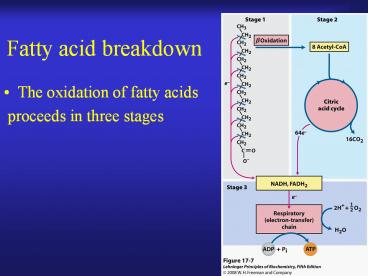Fatty acid breakdown - PowerPoint PPT Presentation
1 / 37
Title:
Fatty acid breakdown
Description:
Fatty acid breakdown The oxidation of fatty acids proceeds in three stages b-oxidation b-oxidation is catalyzed by four enzymes Acyl-CoA dehydrogenase Enoyl-CoA ... – PowerPoint PPT presentation
Number of Views:331
Avg rating:3.0/5.0
Title: Fatty acid breakdown
1
Fatty acid breakdown
- The oxidation of fatty acids
- proceeds in three stages
2
b-oxidation
- b-oxidation is catalyzed by four enzymes
- Acyl-CoA dehydrogenase
- Enoyl-CoA hydratase
- b-hydroxyacyl-CoA dehydrogenase
- Acyl-CoA acetyltransferase (thiolase)
3
First step
- Isozymes of first enzyme
- confers substrate specificity
- FAD-dependent enzymes
- Reaction analogous to succinate
- dehydrogenase in citric acid
- cycle
4
Electrons on FADH2 transferred to respiratory
chain
5
Second step
- Adding water across a double bond
- Analogous to fumarase reaction in
- citric acid cycle
6
Third step
- Dehydrogenation (oxidation)
- using NAD
- NADH is transferred to respiratory
- chain for ATP generation
- Analogous to malate dehydrogenase
- reaction of citric acid cycle
7
Fourth step
- Splits off the carboxyl-end
- Acetyl-CoA and replaces it with
- Co-A Thiolase
8
b-oxidation bottomline
- The first three reactions generate a much less
stable, more easily broken C-C bond subsequently
producing - two carbon units
- through thiolysis
9
The process gets repeated over and over until no
more acetyl-CoA can be generated
- 160-CoA CoA FAD NAD H2O ? 140-CoA
acetyl-CoA FADH2 NADH H - Then..
- 140-CoA CoA FAD NAD H2O ? 120-CoA
acetyl-CoA FADH2 NADH H - Ultimately..
- 160-CoA 7CoA 7FAD 7NAD 8H2O ?
8acetyl-CoA 7FADH2 7NADH 7H
10
Acetyl-CoA can be fed to the citric acid cycle
resulting in reducing power
11
Breakdown of unsaturated fatty acids requires
additional reactions
- Bonds in unsaturated fatty acids are in the cis
conformation, enoyl-CoA hydratase cannot work on
as it requires a trans bond - The actions of an isomerase and a reductase
convert the cis bond to trans, resulting in a
substrate for b-oxidation
12
In some instances (monounsaturated), enoyl-CoA
isomerase is sufficient
13
For others (polyunsaturated), both are needed
14
Complete oxidation of odd-number fatty acids
requires three extra reactions
- Although common fatty acids are even numbered,
odd numbered fatty acids do occur (ie.
propionate) - Oxidation of odd numbered fatty acids uses same
pathway as even numbered - However, ultimate substrate in breakdown has
five, not four carbons, which is cleaved to form
acetyl-CoA and propionyl-CoA
15
Propionyl Co-A enters the citric acid cycle using
three steps
- Propionyl Co-A is carboxylated to form
methyl-malonyl CoA (catalyzed by the biotin
containing propionyl-CoA carboxylase) - Recall that methyl-malonyl CoA is also a
intermediate in the catabolism of methionine,
isoleucine, threonine and valine to succinyl-CoA
16
(No Transcript)
17
Methyl-malonyl-CoA undergoes two isomerization
steps to form succinyl-CoA
- Methyl-malonyl epimerase catalyzes the first
reaction - Methyl-malonyl-CoA mutase (a vitamin B12
dependent enzyme) catalyzes the second to form
succinyl-CoA
18
Vitamin B12 catalyzes intramolecular proton
exchange
19
Vitamin B12 is a unique and important enzyme
cofactor
- Contains cobalt in a corrin ring system
(analogous to heme in cytochrome) - has a 5 deoxy adenosine (nucleoside component
- Has a dimethylbenzimidazole ribonucleotide
component
20
(No Transcript)
21
Attachment of upper ligand is second example of
triphosphate liberation from ATP
- Cobalamin ?
- Coenzyme B12
- The other such reaction
- where this is observed
- is formation of Ado-Met
22
Proposed mechanism for methyl-malonyl CoA mutase
- Same hydrogen
- always accounted
- for
23
Regulation of fatty acid oxidation
- Fatty acids in the cytosol can either be used to
form triacylglycerols or for b-oxidation - The rate of transfer of fatty-acyl CoA into the
mitochondria (via carnitine) is the rate limiting
step and the important point of regulation, once
in the mitochondria fatty acids are committed to
oxidation
24
Malonyl-CoA is a regulatory molecule
- Malonyl-CoA (that we will talk about in more
detail next week in lipid biosynthesis) inhibits
carnitine acyltransferase I
25
(No Transcript)
26
Also
- When NADH/NAD ratio is high b-hydroxyacyl-CoA
dehydrogenase is inhibited - Also, high concentrations of acetyl-CoA inhibit
thiolase
27
Diversity in fatty acid oxidation
- Can occur in
- multiple cellular
- compartments
28
- b-oxidation in peroxisomes and glyoxysomes is to
generate biosynthetic precursors, not energy
29
Distinctions among isozymes
30
Fatty acids can also undergo w oxidation in the ER
- Omega oxidation occurs at the carbon most distal
from the carboxyl group - This pathway involves an oxidase that uses
molecular oxygen, and both an alcohol and
aldehyde dehydrogenase to produce a molecule with
a carboxyl group at each end - Net result is dicarboxylic acids
31
(No Transcript)
32
Omega oxidation is a minor pathway
- Although omega oxidation is normally a minor
pathway of fatty acid metabolism, failure of
beta-oxidation to proceed normally can result in
increased omega oxidation activity. A lack of
carnitine prevents fatty acids from entering
mitochondria can lead to an accumulation of fatty
acids in the cell and increased omega oxidation
activity
33
Alpha oxidation is another minor pathway
34
Ketone bodies are formed from acetyl CoA
- Can result from fatty acid oxidation or amino
acid oxidation (for a few that form acetyl-CoA)
35
Formation of ketone bodies
36
Ketone bodies can be exported for fuel
37
Then broken down to get energy (NADH)































